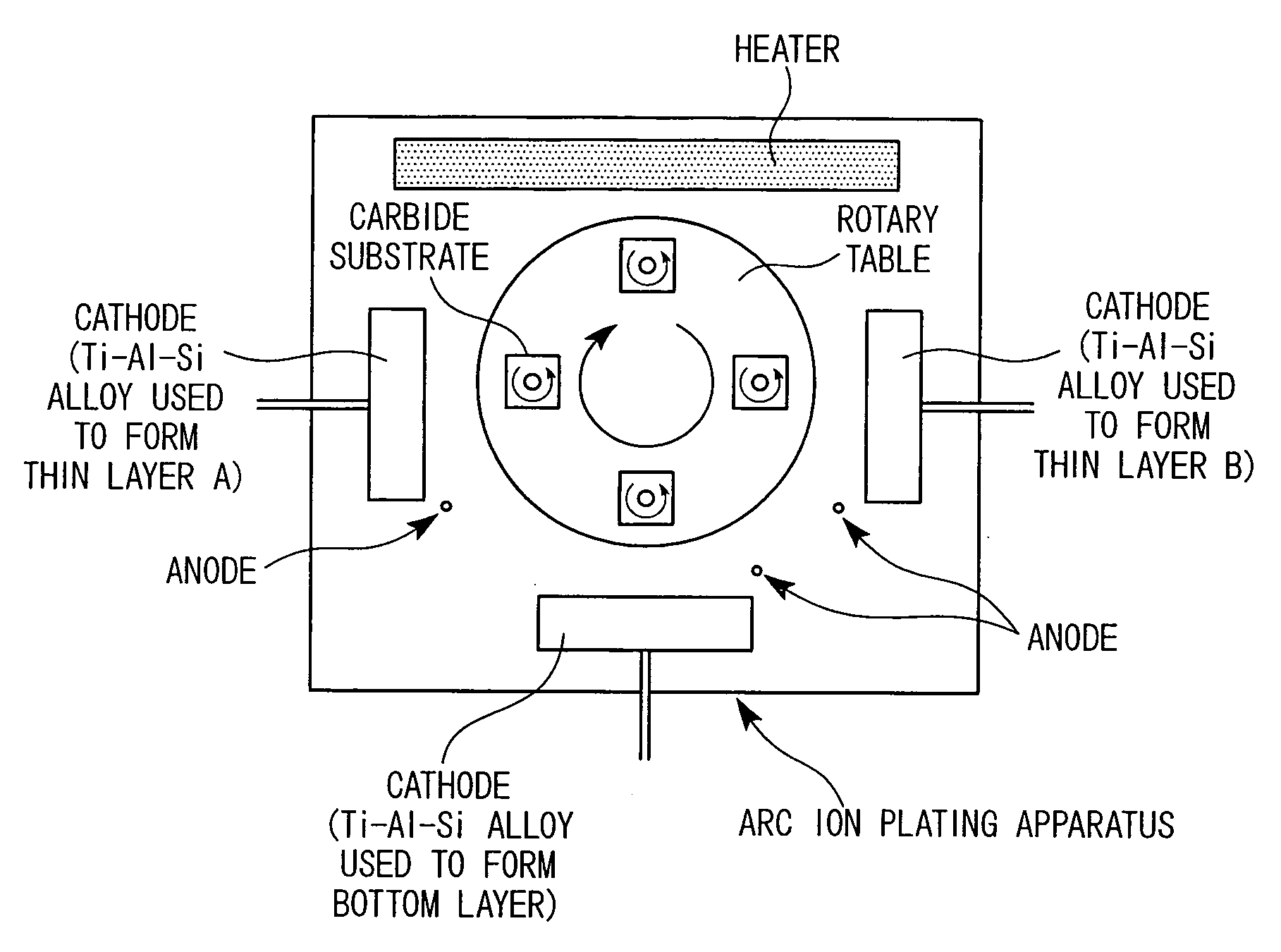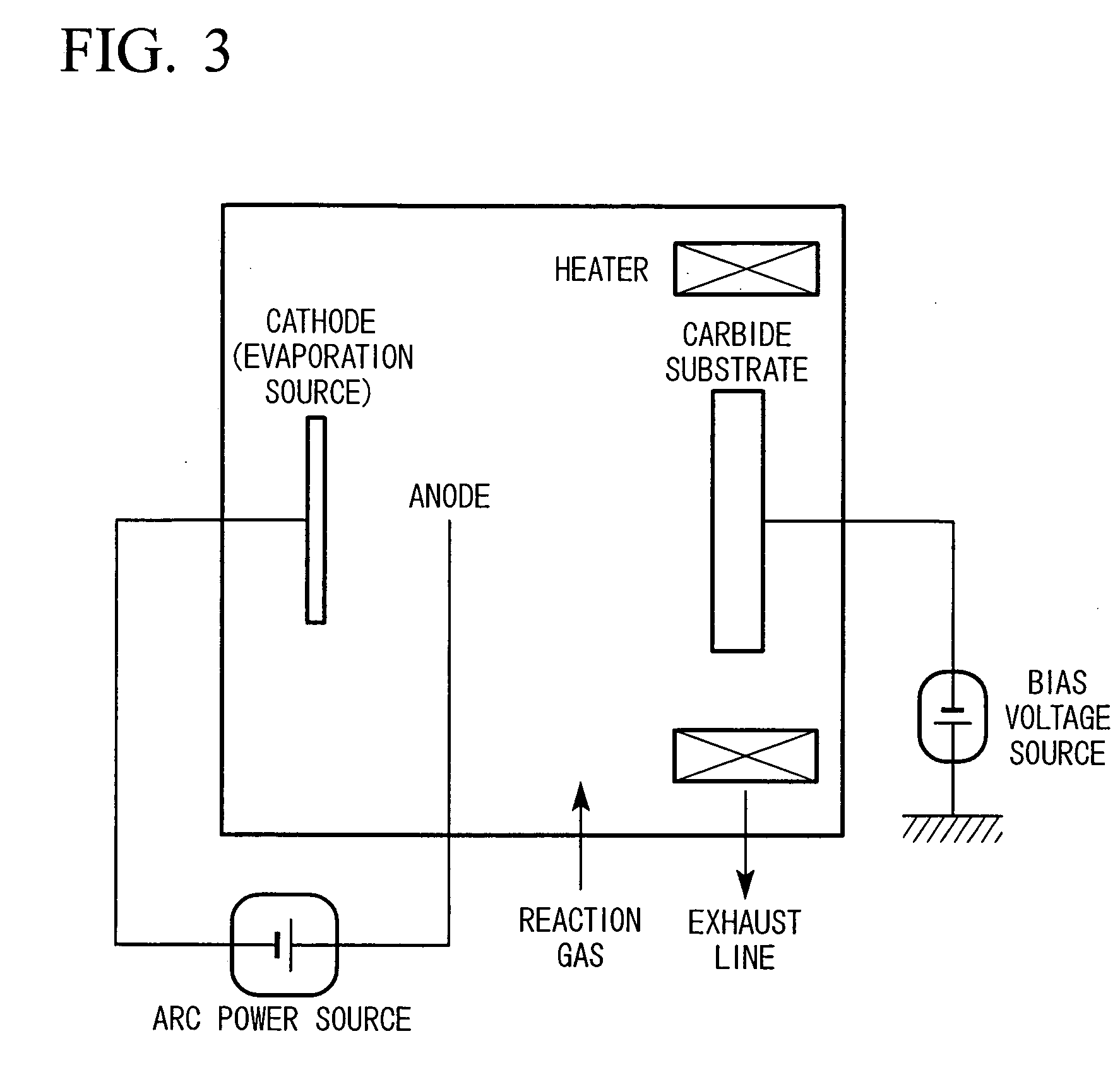Cutting tool made of surface-coated cemented carbide with hard coating layer exhibiting excellent wear resistance in high speed cutting operation of high hardness steel
a cemented carbide and cutting tool technology, applied in the direction of superimposed coating process, other chemical processes, instruments, etc., can solve the problems of significant lower al content and low hardness at high temperatures, and achieve excellent heat resistance, high hardness, and excellent wear resistance.
- Summary
- Abstract
- Description
- Claims
- Application Information
AI Technical Summary
Benefits of technology
Problems solved by technology
Method used
Image
Examples
example 1
[0035] A WC powder, a TiC powder, a ZrC powder, a VC powder, a TaC powder, a NbC powder, a Cr3C2 powder, a TiN powder, a TaN powder and a Co powder, all having a mean particle size in a range from 1 to 3 μm, were prepared as material powders, and were mixed in proportions shown in Table 1, by means of a ball mill in wet process for 72 hours. After drying, the mixture was pressed into a green compact with a pressure of 100 MPa. The green compact was sintered by heating at a temperature of 1400° C. for 1 hour in vacuum of 6 Pa. The sintered material was subjected to honing process to form a cutting edge with a curvature of R 0.03, thereby making carbide substrates A-1 through A-10 made of WC-based cemented carbide having the tip configuration of CNMG120408 specified in ISO standard.
[0036] A TiCN powder (TiC / TiN=50 / 50 in weight proportion), a Mo2C powder, a ZrC powder, a NbC powder, a TaC powder, a WC powder, a Co powder and a Ni powder, all having a mean particle size in a range from...
example 2
[0064] A coarse WC powder having a mean particle size of 5.5 μm, a fine WC powder having a mean particle size of 0.8 μm, a TaC powder having a mean particle size of 1.3 μm, a NbC powder having a mean particle size of 1.2 μm, a ZrC powder having a mean particle size of 1.2 μm, a Cr3C2 powder having a mean particle size of 2.3 μm, a VC powder having a mean particle size of 1.5 μm, a (Ti, W)C powder (TiC / WC=50 / 50 in mass proportion) having a mean particle size of 1.0 μm and a Co powder having a mean particle size of 1.8 μm were prepared as material powder and were mixed in proportions shown in Table 7. Wax was added to this mixture and mixed in acetone in a ball mill for 24 hours. After drying under a reduced pressure, the material was pressed into green compacts of predetermined shape with a pressure of 100 MPa. The green compacts were heated at a rate of 7° C. per minute to a predetermined temperature in a range from 1370 to 1470° C. in vacuum of 6 Pa and were sintered while being he...
example 3
[0085] The three kinds of sintered round rods, having the diameter of 8 mm (used to form the carbide substrates C-1 through C-3), diameter of 13 mm (used to form the carbide substrates C-4 through C-6) and diameter of 26 mm (used to form the carbide substrates C-7 and C-8) made in Example 2 were ground to make carbide substrates (drills) D-1 through D-8 made of WC-based cemented carbide having 2-flute configuration with helix angle of 30 degrees, measuring 4 mm×13 mm (carbide substrates D-1 through D-3), 8 mm×22 mm (carbide substrates D-4 through D-6) and 16 mm×45 mm (carbide substrates D-7 and D-8) in diameter and length of the slot forming section.
[0086] The carbide substrates (drills) D-1 through D-8 were subjected to honing of the cutting edge and were cleaned on the surface with ultrasound in acetone. After drying, the carbide substrates were set in an arc ion plating apparatus as shown in FIG. 1 and FIG. 2, and the bottom layer having (Ti, Al, Si)N layer of single phase struc...
PUM
| Property | Measurement | Unit |
|---|---|---|
| Length | aaaaa | aaaaa |
| Length | aaaaa | aaaaa |
| Nanoscale particle size | aaaaa | aaaaa |
Abstract
Description
Claims
Application Information
 Login to View More
Login to View More - R&D
- Intellectual Property
- Life Sciences
- Materials
- Tech Scout
- Unparalleled Data Quality
- Higher Quality Content
- 60% Fewer Hallucinations
Browse by: Latest US Patents, China's latest patents, Technical Efficacy Thesaurus, Application Domain, Technology Topic, Popular Technical Reports.
© 2025 PatSnap. All rights reserved.Legal|Privacy policy|Modern Slavery Act Transparency Statement|Sitemap|About US| Contact US: help@patsnap.com



